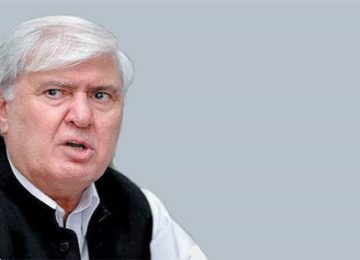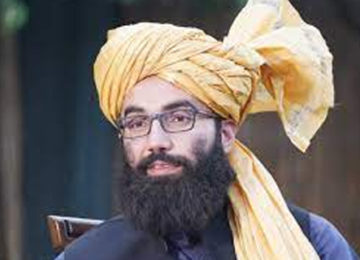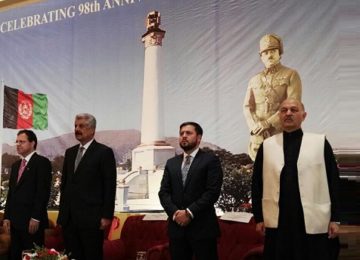October 21, 2018
In our first update of the day, AAN reported on the mixed turnout – far higher in the cities and other secure places and lower in districts where the Taleban could close roads and prevent voting. Those determined to vote faced not only Taleban violence, but also many technical problems and late-opening polling centres. In response, the Independent Election Commission (IEC) ordered an extension of voting hours today for some centres and for some to be opened tomorrow. In others, the count has already begun. The Election Complaints Commission has been damning of the IEC’s management of the poll, saying it could call into question the “transparency and fairness of the elections.” Kate Clark, Thomas Ruttig and the rest of the AAN team, bring you this update of what has turned out to be the first day of Afghanistan’s parliamentary elections.
This is a follow-on from our earlier report on the day’s events. A dossier of our pre-election coverage can also be read here.
Afghanistan’s parliamentary elections were marred by Taleban threats and violence, and chaotic preparations by the IEC.
Taleban violence: rising casualty figures
As the day wore on, reports of attacks and explosions continued to come in – and the casualty figures kept rising. Minister of Interior Wais Barmak told Tolonews at the end of the day that 192 security incidents had been reported countrywide. While this looks like an underestimate, it is still grievous enough.
Barmak told Tolonews at least 17 civilians had been killed and 83 civilians wounded. 10 policemen had also been killed, he said, along with an Afghan National Army soldier, and 17 members of the security forces had been wounded (note: according to the Laws of War, the police, if guarding election sites, would be categorised as civilian). AFP, quoting officials in the late afternoon, reported a somewhat higher civilian casualty figure – 170 civilians killed and injured. Unfortunately, that figure may yet rise. In Baghlan, for example, the Afghan news website, Khabarnama, quoting provincial health officials said that in their province alone, 12 people had been killed and around 100 injured in election-related violence.
In the early evening came reports of a suicide attack on a polling centre in Kabul’s Sar-e Kotal area (PD 17) – between Khairkhana and the Shomali plain: five policemen and ten civilians were killed and 25 more people injured. Kabul, along with Kunduz and Baghlan, suffered the worst of the day’s violence. In Kunduz, where the Taleban sent more than twenty rockets into the city, health officials told AFP that three people had been killed and 39 injured.
Technical shambles
“Participation was good,” the IEC announced at a press conference at the end of the day, “despite problems and security threats.” The commission’s conclusion is curious, even based on its own statistics. By 2 pm, it said, 1,510,659 million people had voted in 27 provinces (it was still waiting for information from Badghis, Kunduz, Paktia, Wardak, Parwan). Even though the final turnout figure will be higher, it still looks as if only a small portion of Afghanistan’s nine million registered voters will have cast their ballots.
[The following two paragraphs have been corrected, 21 Oct 2018, 9.15am] The IEC further said that 4,530 out of the 4,901 polling centres due to open had opened (92 per cent) and that only 370 polling centres had remained closed. There also was an unknown but definitely large number of polling centres that opened late, often hours later, judging by numerous media and other reports that had come in from around the country.
Moreover, the IEC has not specified how many polling centres will open on Sunday 21 October. These centres should include the 370 centres that never opened on 20 October and, according to a decision by the IEC, those that only opened after 1 pm on election day one. The IEC so far has not given that second number. It has also not given the number of how many polling stations closed on time, at 4 pm, or after the extended time, at 8 pm.
To make the confusion complete, a number of polling centres have already started the count “The closing of polls in Saturday’s Parliamentary elections,” wrote AP, “was as chaotic as the opening.”
AAN (see annex and our earlier update) and other observers witnessed the following technical problems:
- Voting centres opening late, including staff turning up late. This affected some areas in particular – such as west Kabul where teachers hired for the elections had, reportedly, not been told which centre they should go to;
- Lack of voting materials;
- Biometric verification devices not working or working only slowly or staff not knowing how to use them;
- Voters with stickers on their tazkeras (to prove they had registered) finding their names missing from the voter lists;
- Long queues, with people having to wait several hours to vote;
- Problems with the Kuchi ballots, with some polling centres not having any.
The IEC itself summed up today’s problems, as follows:
- Ineffectiveness of IEC field staff;
- Technical and administrative issues;
- Polling staff – teachers – not showing up;
- Security incidents perpetrated by insurgents and warlords and the use of force at some polling centres;
- Lack of monitoring in some areas;
- Late arrival of biometric verification devices;
- Negative messages discrediting the process though social media.
The technical, bureaucratic and logistical problems were not evident at every polling centre in the country, but they were widespread enough to warrant AFP’s description of IEC preparations for this long-delayed ballot as “shambolic”.
In mid-afternoon, the country’s Election Complaints Commission (ECC) also came out with a damning statement, listing what it called the “severe shortcomings on how the elections had been managed thus far.” For the first time, it said, it had at least one official in each polling centre to receive complaints from voters, observers and candidate agents and who could report own observations. The ECC therefore, presumably, felt confident in its criticism. Part of the statement, as seen on television, said:
- In a large number of polling centres and stations, polling centres have not been opened and activated yet.
- In a large number of other polling centres and stations, polling centres have been activated after hours of delay.
- In a number of polling centres, the necessary electoral materials, totally or partially, were not provided to the IEC staff on time.
- In some polling centres, the biometric system encountered problems and was not activated on time.
- In some polling centres, observers were prevented [from entering the centres] or faced threats.
- There are reports of boxes containing sensitive electoral materials not being intact.
- In some polling centres, representatives of the ECC were not provided with the opportunity to be present [in the polling stations] or necessary materials were not provided to them.
So far, the impact of violence and mismanagement have overshadowed reports about alleged fraud. AAN has however started collecting reports of incidents and hopes to give a fuller account of this in a future dispatch.
Conclusion
There is no doubt that hundreds of thousands of Afghans turned out to vote, showing commitment and bravery in the face of Taleban threats, and patience in the face of an often shoddily-run election. Where Afghans could vote, it seems they did try. Reports of people waiting several hours to vote were received from many provinces. If these elections were faulty, it was not because of a lack of commitment shown by Afghan citizens. At the end of what has turned out to be in some places, the first day of voting, the conclusion of the ECC may be the one to watch:
[S]erious problems in the management of the elections… have led to the disenfranchisement of some voters, to serious concerns among the citizens and election stakeholders, especially for the ECC. The continuation of the current trend can seriously call into question the transparency and fairness of the elections.
Annex: AAN observation of voter identification and voting
AAN has selected some observations by its researchers from various provinces on how voting went and what problems voters faced. Their reports illustrate why voting hours needed to be extended.
Paktika
In Paktika, many voters complained that their names were not on the voters’ registration list. These were people who had registration stickers on their ID cards, but their names were not on the voter registration list. At the Ali Baba High School, with more than 3,800 voters registered, and the provincial hospital, with 2,247 voters registered, about 200 people found they could not vote and went back home disappointed. According to one tweet, two of Paktika’s candidates also found they were not on the list.
An official that AAN interviewed at the polling centre at the provincial hospital said there were two possible reasons why this had happened.
People got stickers outside of the registration process, ie they got a fake sticker. It might be that they bought or acquired stickers illegally from the IEC officials through a bribe, or the candidates illegally bought stickers to put it on the tazkiras of their people. The second possibility is that their names were among more than 30,000 names that were removed from the main voters’ database, in order to eliminate ‘ghost voters’.
The official did not address the possibility that there had been a bureaucratic muddle. As will be seen below, this was a very common problem.
Other than that, voting seen by the researcher – who visited Sharana and Yusuf Khel and Musa Kheldistricts – went normally and there were no major problems reported. Voters were enthusiastic in Sharana. There were no cases observed where voters refused to be photographed or ‘biometrically verified’. Observers appeared happy with the voting process and did not report irregularities other than the problem of names missing from the voter lists.
Daikundi
248 polling centres were reported open in Daikundi province. At four polling centres seen by AAN in the provincial capital, Nili, the biometric devices were not working. One voter told AAN that in his polling centre, around 150 voters showed up at 8am, only to find the biometric devices not working. He left for work, saying he might return later.
In the polling centre in the Sang-e Mum High School, most of the voters had to queue for two to three hours before they could cast a vote, but said once they got to the front of the queue, it took only a few minutes to vote. Voters reported similar timings in the polling center in Sar-e Nili High School – they waited more than three hours for their turn to vote, but then it took no more than four minutes to cast their ballot. The longest step in voting process, AAN observed in Nilli, was not the fingerprinting, but finding the voter on the voters’ list. The main concern of the voters was that they would not have an opportunity to cast their votes before the polling centres closed, if voting continued to be so slow. The polling centres reported this problem to the IEC.
In the polling centre in Chahar Dar High School, voters were also waiting for two and a half hours and then found it took five minutes to vote. There was no room in the polling stations for all the observers, so they were taking turns to monitor. They told AAN that 13 voters, with stickers issued from the centre, found their names were not on the voter list.
Takhar
In Taloqan city, most of the poling stations had closed their doors by 4pm and counting had begun. Candidates’ agents continued to monitor. AAN visited around 20 polling stations and found some irregularities, with mismanagement and technical issues to do with the biometric devices and voters lists, mainly in the morning. There were no obvious signs of manipulation or fraud.
In most of the polling stations there were problems with the biometric system. For instance, in Bibi Marya, the biometric system in the women’s polling station did not work until 8:45am. IEC officials also had trouble finding people’s names on the voter lists. It took more than five minutes for the queue controllers to find each voter and check their name and sticker. In a few cases, AAN noticed voters had to go from one polling station to another to find their names. Observers and agents also raised no serious issues of concern; most of their complaints were about technical problems.
Outside the provincial capital, though, the security forces came under criticism from many candidates who complained they had not been able to secure the area and allow people to vote in Dasht-e Qala, Durqad, Yang-e Qala, Khawja Bahauddin and Khawja Ghar districts.
Balkh
The polling centre in the Oil and Gas Institute in Mazar-e Sharif opened 20 minutes late. The biometric machines worked properly, but turnout was very low, at least initially. AAN observed some voters taking photos of the ballot paper while voting (a female observer also said she saw women photographing their ballot papers). They explained they had sold their votes and needed to take the photos as proof. (Photographing ballot papers is illegal – see here). There were 80 to 85 male observers, mainly candidates’ agents. A female observer told AAN there were 40 female observers, but the female voter turnout was very low in the centre.
In the Kart-e Bokhdi area of Mazar, an observer told AAN the polling centre was very crowded and that it had run out of ballot papers.
The voting process took between three and five minutes in most polling centres in Mazar, while checking the voter’s tazkeras against the voter registration took a little longer.
One observer told AAN that many centres had received the wrong voters’ lists, and that voters who were not on the list of the polling station they had (or thought they had) registered and were sent to wander from centre to a centre in search of their names. AAN interviewed one female voter whose name the IEC staff said they had been unable to find. She was asked to wait outside for one hour, but went home instead, without voting.
Herat
In Herat city, polling centres opened an hour late, at around 8am. However, it seems there was a good turnout. Beginning from about 6:30am, queues were already forming, for men outside the polling centres and for women inside. The queues were already long by 08:00am when the polling centres opened.
In the districts, some polling centres opened much later. One in Guzara district opened at 11:00am. Polling centre officials said election materials had not been provided to them. In some polling centres, election staff did not come on time. Many people have had to wait for more than an hour to get into the polling station.
It generally took more than ten minutes for each voter to cast their vote (less than five minutes in less busy stations). In some cases, the biometric equipment was not working. A more common problem was that the names of some voters could not be found on the voter list, despite having the relevant sticker of the polling centre pasted on their tazkera.
By Special Arrangement with AAN. Original link.
Disclaimer: Views expressed on this blog are not necessarily endorsed or supported by the Center for Research and Security Studies, Islamabad.








